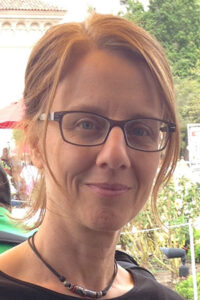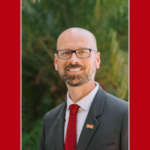
Kristen Hill Maher, associate professor in political science at San Diego State University.
With all the current controversy surrounding refugees and immigration, a new One-Unit Weekend course at San Diego State University will provide students the unique opportunity to get a bottom-up perspective on what it means to build a life in a new and sometimes hostile environment.
Refugees in San Diego: Struggling for Solutions will include an overview of the basics of law and policy, insights from experts — including visiting professors from Cornell University and Finland — visits to four local organizations that assist newcomers, and the chance to talk directly with refugees.
“I am excited about this class!” said instructor Kristen Hill Maher, an associate professor in political science at SDSU. “I am a big believer in education reaching outside the traditional classroom, and the weekend class format permits us to get out into the community in ways that I cannot do in my regular immigration class. The main idea is to offer students a chance to hear different perspectives on refugees than we otherwise tend to get from news and politicians.”
One-Unit Weekend courses allow undergraduate students to earn extra units for graduation while also learning about the latest developments on important current issues. Offered through the College of Extended Studies, each course typically meets two or three times for a total of 15 classroom hours.
Refugees in San Diego: Struggling for Solutions will meet Friday, Feb. 24, 2–4 pm; Friday, March 3, 10 am–5 pm; and Saturday, March 4, 9 am–5 pm. The registration deadline is Feb. 24.
As evidenced by Maher’s course, One-Unit Weekend topics are so intriguing that community members often take advantage of the fact that they’re open to the public. Maher answered a few questions about her course and her career.
Please give us a brief history of your education and career.
I am one of those people who rambled a bit in finding my niche. I began college in the Midwest as a music major and ended up with a B.A. in English. Toward the end of my degree, I discovered politics and worked a short while in New York City in urban redevelopment, which was compelling but frustratingly difficult. In response to that experience, I went to graduate school with the idea that I would figure it all out and save the world. Needless to say, graduate school in political science was a disappointment in that regard, as deep study reveals complexities more than truths. On the other hand, I discovered new passions and developed tools to act meaningfully in the world. I received my M.A. from the University of Iowa and my Ph.D. from the University of California-Irvine. Along the way, I developed a fascination with immigration and border politics — topics that are widely misunderstood — and those have formed the heart of my research and teaching ever since.
When did you first become politically aware?
I did not grow up paying attention to politics at all. My first real political engagement happened during a university exchange semester in New York, where I discovered various churches involved in the Sanctuary Movement protecting people from El Salvador who had fled death squads and torture. They were being denied asylum by the United States because our government had allied with the right-wing military regime in power in El Salvador. Meeting people in that situation was a real wake-up call.
Tell us about your course — Refugees in San Diego: Struggling for Solutions.
San Diego is a key refugee resettlement center, and so it is an ideal place to learn about what refugees experience after they arrive, and what it means to build a new life here. After covering some basics for two hours on the first day (Feb 24), we’ll spend a full second day (March 3) visiting four nearby organizations that support newcomers in various ways: helping them find apartments and jobs, working on skills training, supporting entrepreneurs, offering therapy for those who have experienced trauma, and so on. We’ll hear from experts, and we’ll talk with refugees themselves. Two of the organizations we’ll visit are run largely by refugees working within their own communities: one serving Somalis, and the other serving the Karen ethnic group from Burma.
The following day (March 4), we’ll meet with the director of an organization that helps high-skilled refugees get certified to use their skills here in the U.S., and we’ll process all we heard and saw. By the end of the class, students should have a broad sense of what it takes for new refugees to become “integrated” legally, socially, culturally, and economically.
One other exciting aspect of this course is that there are other professors who will be joining us for parts of the process, including a visiting professor from Cornell University and two professors visiting from Finland, who work on refugee resettlement there. We are going to have some really interesting conversations!
What will students be surprised to learn – both from the class and the field trips?
I think students will be stunned by how much some refugees have endured, but also by how resilient they have been. These are people who have been through hell. They’ve lost everything. And yet they have tapped their own strength and creativity to start over and contribute in all kinds of wonderful ways to the community here. Students may not even realize that some of the people they already know and admire arrived as refugees.
They may also be surprised to learn about how the vetting and resettlement process works. There is a lot of talk about how we “don’t know anything” about refugees coming to the U.S. In truth, they go through the longest, most elaborate security screening of any immigrants to the U.S., a process that often takes years before they actually arrive.
What’s the difference between refugees and asylees?
Both refugees and asylees are people who had to flee their home countries because of persecution or violence. They have to meet the international legal standard of someone who has a “well-founded fear of persecution” based on their race, religion, nationality, or membership in a particular social group. They have to show that their own government will not protect them, either because they are the perpetrators, or because they look the other way.
What is the difference? Refugees receive that designation while they are still abroad and enter the U.S. after a long vetting process with a visa and the right to a limited period of government assistance after they first arrive. Asylum-seekers, instead, request protection after arriving. They then go through a court process to determine whether they meet the standards, and a security clearance process before gaining legal status as an asylee.
Who should take this course?
I welcome anyone with an interest in the content. Also, the single unit is very handy for students who find themselves a unit short. The course is being offered for upper-division political science credit, but after talking with advisers in other departments, it seems very likely that students in related disciplines might be able to petition to have the unit count toward their major.
Are there viable solutions for refugees in San Diego?
That is one of the key questions we’ll be addressing. We’ll learn about the wide range of challenges that need solutions, and the incredible array of ways that people are working to solve them. Some challenges are tougher to solve than others, of course.
You’ve conducted field studies in Southern California (and other places) on international migration and border politics. Can you give us a glimpse of what that’s like? Do you travel with an interpreter, must you be under cover of night, etc.
I like the suggestion that I might need to lurk about in the cover of night like a film noir spy in order to do this research. Alas, it has never required a fedora. However, I love the way that fieldwork brings me into the lives and living rooms of all kinds of people I would otherwise never encounter, both in the U.S. and in other countries. I have also enjoyed ethnography, an approach where I join people in various settings and take notes as a participant observer, so that I can watch and hear people interact in a more organic way. My all-time favorite research site has been Tijuana, a fascinating place that never fails to surprise me, and where simply finding my way around becomes an adventure. And holy cats, the food is good. When I have felt over my head operating in another language, I have worked with others in research teams, ensuring that someone else would be able to catch anything I missed or phrase questions more gracefully.
I hear you write and play music with a local band. What kind of music and what instrument do you play?
My band has always struggled to define our genre of music. The closest we can come is to call it eclectic Americana, since we draw on all kinds of music that emerged here — folk, blues, jazz, bluegrass — both covers and originals. We have a democratic policy where we take turns choosing what to play, and we trade off the lead, which helps explain the range of styles. I have always loved to sing, and I also play keyboard and guitar in the band. I “faux play” accordion, banjo, or bass in a pinch, but one shouldn’t watch or listen too carefully.
Anything you’d like to add?
Anyone who would like to learn more about the course can feel free to contact me directly at kmaher@sdsu.edu.
Learn more about One-Unit Weekend courses at neverstoplearning.net/oneunit.




